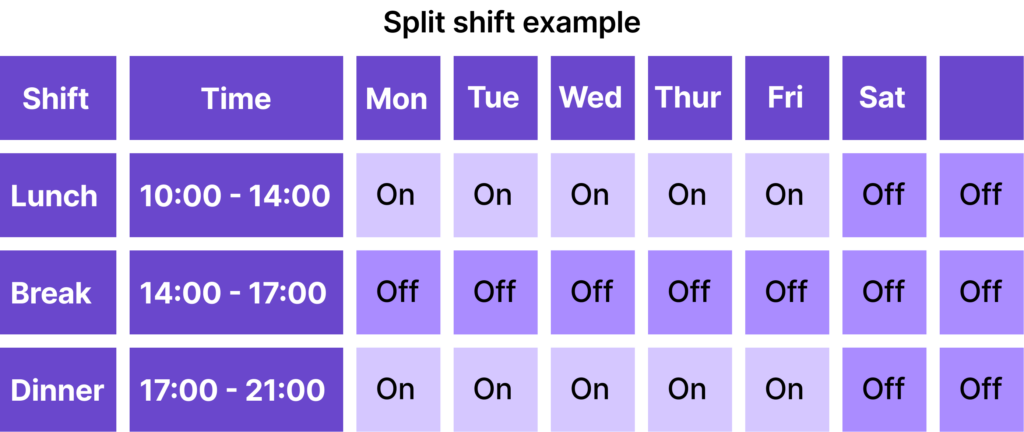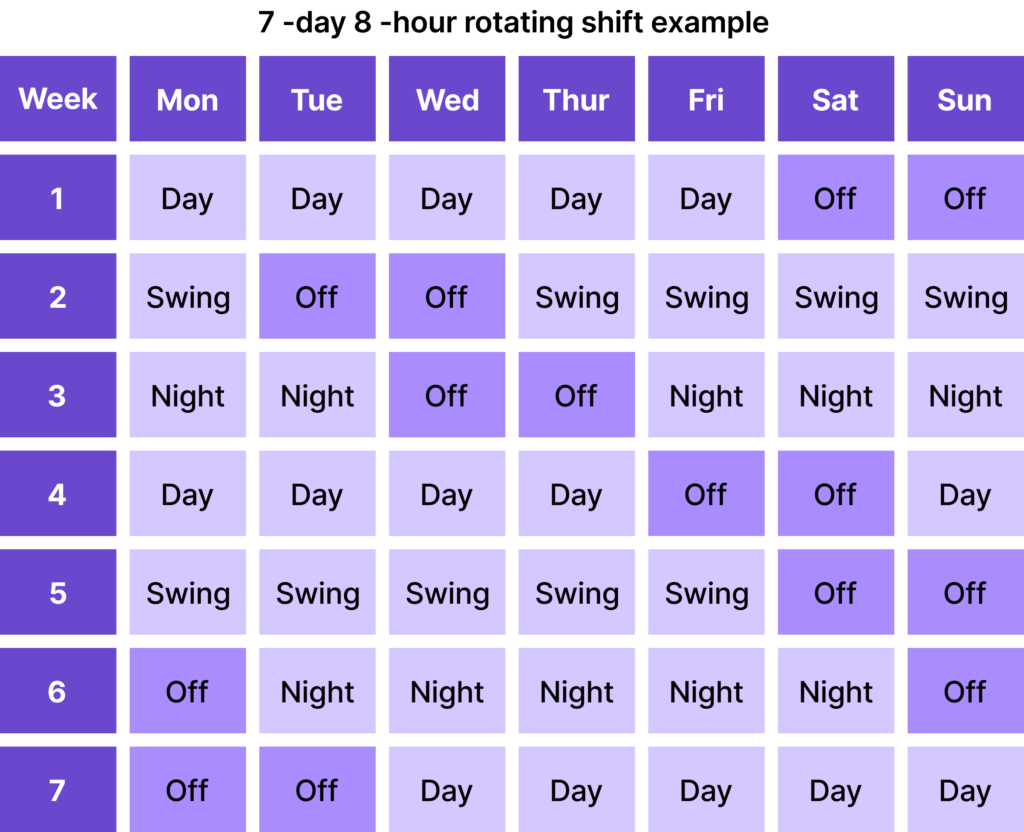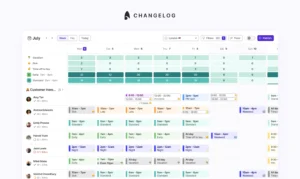
5×8 schedule: Definition, sample, pros & cons

Call centre managers constantly seek ways to enhance productivity, boost employee morale, and deliver exceptional customer service.
The 5×8 schedule is a structured approach that offers a promising solution, allowing managers to optimise surfer availability and maintain a healthy work-life balance for their teams.
Let’s learn more about 5×8 schedules in this comprehensive blog.
What is a 5×8 schedule?
A 5×8 schedule is a work arrangement where employees work five days a week, typically Monday to Friday, and complete eight-hour shifts daily. This results in a standard 40-hour work week.
Here is an example what a 5×8 schedule looks like:

The 5×8 work schedule is popular in industries such as call centres, manufacturing, healthcare, and public safety, where round-the-clock coverage is required, and it offers several benefits, including:
- Longer weekends: Employees get a two-day weekend, allowing more time for personal activities, family, and relaxation.
- Reduced commuting: With two fewer days of commuting per week, employees can save on transportation costs and reduce their environmental impact.
- Operational efficiency: Businesses may benefit from longer shifts as it reduces transition time and provides longer periods of uninterrupted work, increasing productivity
- Employee satisfaction: Having more consecutive days off can improve employees’ work-life balance and job satisfaction.
Note: Managers must ensure that surfers receive adequate breaks and rest periods during the 8-hour shifts to prevent burnout and maintain productivity.
What are a few alternative work schedules?
While a 5×8 work schedule is advantageous for some, it may not suit all industries or job roles. Here is a list of alternative schedules that businesses can implement.
4×10
A 4×10 work schedule is when employees work four days a week, each workday comprising ten hours. This schedule allows for a full-time workload of 40 hours per week while providing an additional day off during the workweek.
Here’s an image to understand what a 4×10 work schedule is👇

Pros and cons of working 4×10 hours
| Pros | Cons |
|---|---|
| Longer weekends provide more leisure time. | Limited availability for appointments during weekdays. |
| Reduced commuting frequency. | Challenges in adjusting to longer work hours. |
| Increased employee satisfaction. | A potential decline in productivity towards the end of the day. |
Split work schedule

A split work schedule involves dividing the workday into two or more separate shifts, typically with a break in between. This allows employees to have different work and rest periods, providing flexibility in managing work-life balance and accommodating varying business needs.
For example, if a company operates from 9 am to 6 pm. You can implement a split schedule with two shifts: 9 am to 1 pm (Shift A) and 2 pm to 6 pm (Shift B). This allows employees to work in either shift, providing coverage from 9 am to 6 pm while allowing breaks.
Pros and cons of a split work schedule
| Pros | Cons |
|---|---|
| Flexibility to accommodate personal commitments. | Potential disruption of work-life balance. |
| Opportunity for part-time or multiple jobs. | Difficulty in establishing a consistent routine. |
| Reduced commuting time and expenses. | Challenges in coordinating with colleagues and teams. |
| Potential for higher earnings. | Increased risk of fatigue and burnout. |
Part-time work schedule
A part-time work schedule is a work arrangement where employees work fewer hours than full-time employees, typically less than 40 hours per week. Part-time schedules offer flexibility and can be ideal for individuals balancing other commitments or seeking reduced work hours.
To understand this, consider a company with full-time employees working 40 hours per week. It can also hire part-time employees to work 20 hours per week, allowing them to work half the hours of full-time employees while still contributing to company sales.
Pros and cons of a part-time work schedule
| Pros | Cons |
|---|---|
| Flexibility to pursue other interests or commitments. | Lower income compared to full-time work. |
| Reduced work hours and potential for better work-life balance. | Limited access to certain benefits and job security. |
| Opportunity to gain experience or pursue education concurrently. | Limited career advancement opportunities. |
| Less stress and potential for improved well-being. | Possible challenges in coordinating schedules with others. |
| Ability to maintain a part-time job alongside personal responsibilities. | Potential difficulty in securing consistent work hours. |
Rotating shift work schedule

A rotating shift work schedule is a system where employees work different shifts on a rotating basis, such as day, evening, and night shifts, to cover 24-hour operations. This schedule often changes weekly or monthly, requiring employees to adjust their sleep and daily routines accordingly.
Pros and cons of a rotating shift work schedule
| Pros | Cons |
|---|---|
| 24/7 coverage for round-the-clock operations. | Disruption of sleep patterns and unhealthy lifestyle. |
| Variety in work schedules and tasks. | Increased risk of fatigue, stress, and health issues. |
| Opportunity for shift differentials and higher pay rates. | Difficulty in establishing consistent routines and maintaining work-life balance. |
Round-robin scheduling
Round-robin scheduling is a method of evenly allocating work among a team, ensuring each member has an equal opportunity to handle tasks or shifts. It prevents overload and burnout by sequentially assigning tasks or customer requests, promoting fair distribution and maintaining productivity within the team.
Round-robin scheduling is important for customer support teams because it ensures:
✔️ Fair distribution of work
✔️ Improved customer satisfaction
✔️ Reduced burnout and improved morale
Surfboard’s round-robin scheduling tools fairly distributes shifts across team members automatically, including allocating time off in lieu. Teams can set up and schedule multiple round-robins within minutes.
5×8 work schedule example
Let’s consider a call centre operating with a 5×8 work schedule where the workweek starts on Monday.
Team A consists of five customer service representatives: Sarah, John, Lisa, David, and Emily.
| Days | Surfers | Time |
|---|---|---|
| Monday | Sarah | 8:00 AM – 5:00PM |
| Tuesday | John | 8:00 AM – 5:00PM |
| Wednesday | Lisa | 8:00 AM – 5:00PM |
| Thursday | David | 8:00 AM – 5:00PM |
| Friday | Emily | 8:00 AM – 5:00PM |
Here, the team follows a 5×8 work schedule, working eight hours per day for a total of 40 hours per week. They have the weekends off, giving them two consecutive days of rest on Saturday and Sunday.
Note: The specific work and rest days may vary depending on the organisational requirements, shift rotation, or employee preferences.
Rotating 5×8 work schedule example
Let’s consider a call centre operating with a rotating 5×8 work schedule where the workweek starts on Monday and rotates among four teams: Team A, Team B, Team C, and Team D.
Schedule for Week 1:
| Days | Teams | Time |
|---|---|---|
| Monday | Team A | 8:00 AM – 5:00PM |
| Tuesday | Team B | 8:00 AM – 5:00PM |
| Wednesday | Team C | 8:00 AM – 5:00PM |
| Thursday | Team D | 8:00 AM – 5:00PM |
| Friday | Team A | 8:00 AM – 5:00PM |
Schedule for Week 2:
| Days | Teams | Time |
|---|---|---|
| Monday | Team B | 8:00 AM – 5:00PM |
| Tuesday | Team C | 8:00 AM – 5:00PM |
| Wednesday | Team D | 8:00 AM – 5:00PM |
| Thursday | Team A | 8:00 AM – 5:00PM |
| Friday | Team B | 8:00 AM – 5:00PM |
This way the schedule follows a rotating pattern for weeks.
In this example, each team follows a 5×8 work schedule, working eight hours per day for 40 hours per week. The teams rotate their schedules, so the specific work and rest days vary depending on the week and the team’s assigned days. Each team has two consecutive days off, providing them with a rest period over the weekend.
Pros and cons of working a 5×8 work schedule
Here are the pros and cons of working 5×8 work schedule, divided into different sections:
Pros
- Regular weekends: Employees have a consistent two-day weekend, allowing for rest, personal activities, and family time.
- Work-life balance: The schedule balances work and personal life, allowing employees to pursue hobbies, engage in social activities, and maintain relationships.
- Less fatigue: Working eight hours a day is generally less physically and mentally exhausting compared to longer shifts, promoting employee well-being and reducing the risk of burnout.
- Ease of scheduling: The standard 5×8 schedule aligns with traditional business hours, making it easier to schedule meetings and coordinate with others.
Cons
- Limited flexibility: Employees may have limited flexibility in scheduling personal appointments or handling unexpected situations during traditional work hours.
- Commute time: A five-day workweek may result in more frequent commuting, leading to additional travel time and transportation costs.
- Transition time: Each workday starts and ends separately, requiring employees to adjust to work mode and wind down at the end of the day, potentially impacting productivity.
- Workload distribution: The shorter workday may not be sufficient for certain job roles or industries with higher work demands, leading to a potential need for additional shifts or overtime.
It’s important to note that the pros and cons can vary depending on individual preferences, job requirements, and the specific industry or organisation.
Plan your work schedules intuitively with Surfboard
Are you planning a 5×8 work schedule or a compressed workweek (4 days work instead of 5) for your employees?
Regardless of what you choose, Surfboard’s automated and fairly distributed scheduling feature can help you.
Surfboard allows you to utilise accurate forecasts to create schedules and seamlessly integrates with your existing systems. You can also send shift reminders and notifications to managers and support surfers during schedule changes. Here are some of Surfboard’s top features👇
✅Workforce scheduling – Create custom shift patterns and plans for all your team’s needs across the year
✅Employee shift scheduling– Build shift plans and patterns from scratch based on the unique needs of your team
✅Intraday scheduling– Automate your scheduling across days, weeks, and months.
Learn how Surfboard helped Lick, a home decor provider, reduce planning time by 75%. The company managed part-time and full-time staff schedules with forecasting and provided heatmaps for manual adjustments.
Book a demo with us to learn if Surfboard is a fit for your team as well.
FAQs
What is a 5×8 work schedule?
A 5×8 work schedule refers to a standard full-time work arrangement where employees work five days a week, with each day consisting of eight hours. This schedule is common in many industries and follows the traditional Monday-to-Friday workweek.
What are the hours of the 5th Shift?
In a traditional 5×8 work schedule with five days of work per week, the “5th Shift” would typically be on Friday. The hours for the 5th Shift would depend on the specific company or organisation’s operating hours and policies.
Common working hours for the 5th Shift could be from 8:00 AM to 5:00 PM or 9:00 AM to 6:00 PM, but this can vary based on the employer’s needs and the industry.
5×8 vs. 4×10 schedules – Which is better?
The “better” schedule depends on individual circumstances, job requirements, and personal preferences. Some may prioritise consistent routine and shorter daily shifts (5×8), while others may value extended weekends and greater work-life balance (4×10).
Consider this comparison:
| Requirements | 5×8 Schedule | 4×10 Schedule |
|---|---|---|
| Consistent work hours and routine | ✅ | ❌ |
| Longer weekends for personal activities | ❌ | ✅ |
| Reduced commuting time and expenses | ❌ | ✅ |
| Handling higher work demands | ✅ | ❌ |
| Opportunity for additional shifts/overtime | ✅ | ❌ |
What does 5×8 mean in a work schedule?
In a work schedule, a 5×8 schedule means employees work five days a week, and each day, they have an 8-hour shift.
Week 1
Monday – 8 hours
Tuesday – 8 hours
Wednesday – 8 hours
Thursday – 8 hours
Friday – 8 hours
Saturday – Off
Sunday – Off
What are the benefits of a 5×8 work schedule?
Here is the list of benefits a 5×8 work schedule offers;
- Improved work-life balance with regular two-day weekends.
- Reduced employee fatigue and burnout.
- Increased employee productivity and focus during shorter workdays.
- Easier scheduling for personal appointments and commitments.
- Enhanced employee satisfaction and morale.
- Potential cost savings with reduced overtime expenses.



